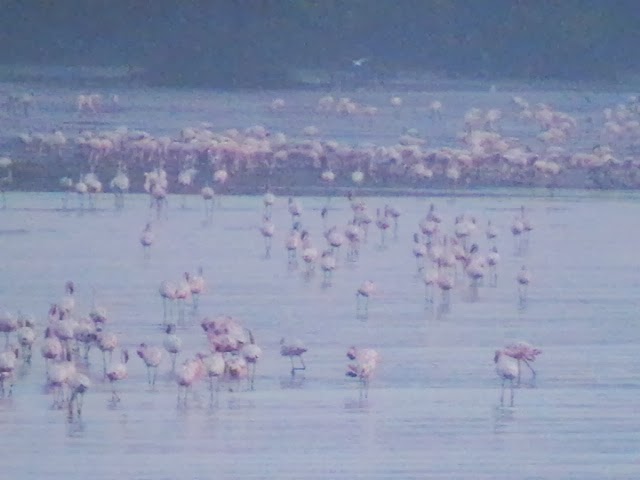I was introduced to Sanctuary Asia last year at Aircel initiated blogger's meet. Bittu Sahgal, the founding editor of Sanctuary Asia was one of the panelists at "Tiger as a Metaphor for all of Nature" meet. Bittu Sahgal is an environmental activist who has been working on conservation of wildlife and protection of the country from the worst impacts of climate change. Sanctuary Asia had organised "Flamingo and Wader watch" on 27th Feb at Sewri jetty. So it was just not a bird watch event, but to create awareness on conservation of these magnificant creature.
As 27th was a holiday, thought of not missing this opportunity as I had heard, it was always preferred to visit Sewri in groups. As per the tide timings the best time for the watch was 7 to 8:30am and to reach at 7, had to leave home by 6am. Kiddo very much eager to watch Flamingos, woke up on time and there we were at Sewri jetty by 7am, with other birdwatchers. The best part of the event was, they had arranged spotting scopes and binaculors for watching the magnificant birds. Mentor Dr. Parvish Pandya introduced us to Flamingos and their migration to Mumbai's coastline for breeding.
Of the world's five species of flamingos two occur in Indian subcontinent, the greater flamingos and the lesser flamingos. The greater flamingos are said to be the tallest of all the species with an average of 4 feet. The lesser flamingos compensate for their shorter stature by richness of their colour. The largest population of these species nest and breed at the Great Rann of Kutch in Gujrat. About 12-15 percent of the entire South Asian population of the lesser Flamingos is said to immigrate to Sewri, others have to travel all the way to Africa's Lake Nakuru. Its also said relatively lesser inhibit Thanjavur Dist in Tamil Nadu, Chilka in Orissa and Samhar Lake in Rajasthan. Soda lakes, salt lagoons and tidal mudflats form the habitats of flamingos, for the crustaceans, worms and blue green algae which they feed on. The pink colour of the flamingo is due to the pink pigment found in algae.
The birds were very far and could be only viewed with spotting scope, below were few pics I was able to click with my cam.
The birds were very far and could be only viewed with spotting scope, below were few pics I was able to click with my cam.






oh wow. . nice view of flamingoes..
ReplyDeleteYes Smitha, thoroughly enjoyed the event..
DeleteGreat captures.
ReplyDeleteThanks Indrani, I realised my camera badly needs an upgrade for nature trails.
DeleteIt's about time you upgraded...
DeleteI need to Rahul Krishnan...
DeleteWhat a lovely sight with all those flamingos!
ReplyDeleteThank you ladyfi..
DeleteInteresting serie of photos!
ReplyDeleteThank you HansHB..:)
Deletethey are so beautiful, I've always been intrigued by flamingos.
ReplyDeleteThank you Laura.. :)
DeleteAmazing.. Really liked it :)
ReplyDeleteWow, very cool to see all the flamingos. What a neat place to visit. Great captures. Have a happy day!
ReplyDelete